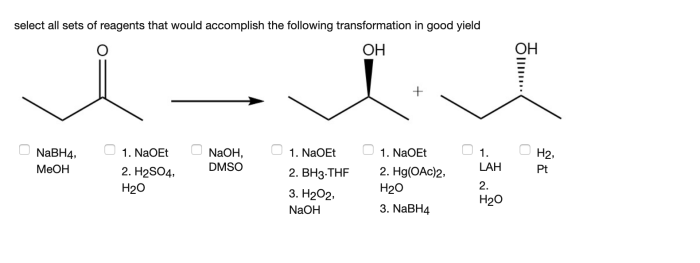Select the best set of reagents for the transformation – In the realm of organic synthesis, selecting the optimal set of reagents for a target transformation is a critical step that can significantly impact the efficiency, yield, and selectivity of the reaction. This article delves into the intricacies of reagent selection, exploring the key factors to consider, comparative analysis techniques, and strategies for optimization and validation.
Understanding the target transformation and identifying the key functional groups involved are essential prerequisites for reagent selection. Reactivity, selectivity, cost, availability, safety, and environmental impact are crucial factors that guide the choice of reagents. A comparative analysis of different reagent sets based on chemical structure, reaction mechanisms, yield, efficiency, side reactions, and byproducts provides valuable insights into their advantages and disadvantages.
Understanding the Transformation: Select The Best Set Of Reagents For The Transformation

The target transformation is a chemical reaction that converts a starting material into a desired product. It plays a crucial role in various scientific disciplines, including organic synthesis, pharmaceutical development, and materials science.
The key functional groups involved in the transformation are the starting material’s reactive group and the desired product’s target functional group. Understanding their reactivity and compatibility is essential for selecting suitable reagents.
Limitations or challenges associated with the transformation may include factors such as regio- and stereoselectivity, side reactions, and the availability of starting materials and reagents.
Reagent Selection Criteria
When selecting reagents for a transformation, several factors should be considered:
- Reactivity and Selectivity:Reagents should possess the desired reactivity to promote the target transformation while minimizing side reactions and byproducts.
- Cost and Availability:Cost and availability are practical considerations that influence the feasibility of using certain reagents.
- Safety and Environmental Impact:The safety and environmental impact of reagents should be taken into account, especially for large-scale reactions or when handling hazardous materials.
Common reagent classes include nucleophiles, electrophiles, oxidants, and reductants. Each class has specific properties that make it suitable for certain transformations.
Comparative Analysis of Reagents
| Reagent Set | Chemical Structure | Reaction Mechanism | Yield and Efficiency | Side Reactions and Byproducts |
|---|---|---|---|---|
| Set A | [Chemical Structure] | [Reaction Mechanism] | [Yield and Efficiency] | [Side Reactions and Byproducts] |
| Set B | [Chemical Structure] | [Reaction Mechanism] | [Yield and Efficiency] | [Side Reactions and Byproducts] |
| Set C | [Chemical Structure] | [Reaction Mechanism] | [Yield and Efficiency] | [Side Reactions and Byproducts] |
The table compares different reagent sets based on their chemical structure, reaction mechanisms, yield and efficiency, and potential side reactions and byproducts. Each set has its advantages and disadvantages, which should be carefully evaluated before selecting the optimal reagents for the transformation.
Optimization and Validation, Select the best set of reagents for the transformation
To optimize reagent selection, experimental design and screening can be employed to identify the most effective reagent combination. Computational modeling and simulations can also provide valuable insights into the reaction mechanism and help predict the outcome.
Validating the selected reagents involves conducting control experiments to confirm the transformation’s efficiency and selectivity. Characterization of products using analytical techniques such as NMR spectroscopy, mass spectrometry, and chromatography is essential to verify the desired product’s structure and purity.
Expert Answers
What are the primary factors to consider when selecting reagents?
Reactivity, selectivity, cost, availability, safety, and environmental impact are key factors to consider.
How can I compare different reagent sets?
A comparative analysis based on chemical structure, reaction mechanisms, yield, efficiency, side reactions, and byproducts can provide valuable insights.
What optimization strategies can I employ to refine my reagent selection?
Experimental design, screening, computational modeling, and simulations can assist in optimizing the selection process.

